

![]()
DAF CARS: RALLY & RACING
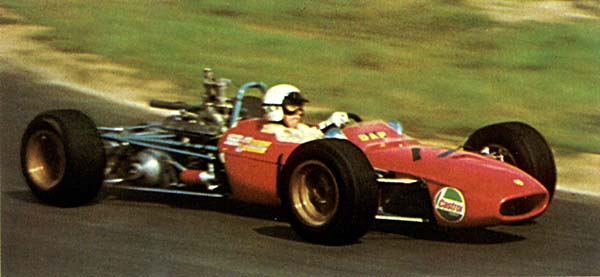 In the late sixties DAF wanted to get rid of their plain image and prove the
capabilities of their Variomatic CVT transmissions. DAF decided to set up a competitions
department (run by Rob Koch) and started a Formula 3 program in 1965. In 1967 DAF entered
two cars in F3, based on Brabham chassis and adapted by a firm called "The Chequered
Flag". These cars carried the DAF name and were raced by Van Lennep and Beckwith, who
each won a race that year. The CVT system was modified for these racing cars by Wim
Hendriks. Cosworth engines were used, tuned for top-end power because the CVT system took
care of the necessary flexibility.
In the late sixties DAF wanted to get rid of their plain image and prove the
capabilities of their Variomatic CVT transmissions. DAF decided to set up a competitions
department (run by Rob Koch) and started a Formula 3 program in 1965. In 1967 DAF entered
two cars in F3, based on Brabham chassis and adapted by a firm called "The Chequered
Flag". These cars carried the DAF name and were raced by Van Lennep and Beckwith, who
each won a race that year. The CVT system was modified for these racing cars by Wim
Hendriks. Cosworth engines were used, tuned for top-end power because the CVT system took
care of the necessary flexibility.
Development costs were high and competition was strong in F3. After 1967 the DAF
involvement in F3 diminished. They made a few cars based on Tecno chassis (as seen on this
picture) and experimented with the placing and lay-out of the transmission, but never were
competitive anymore. By 1970 DAF had turned away from single-seater racing.
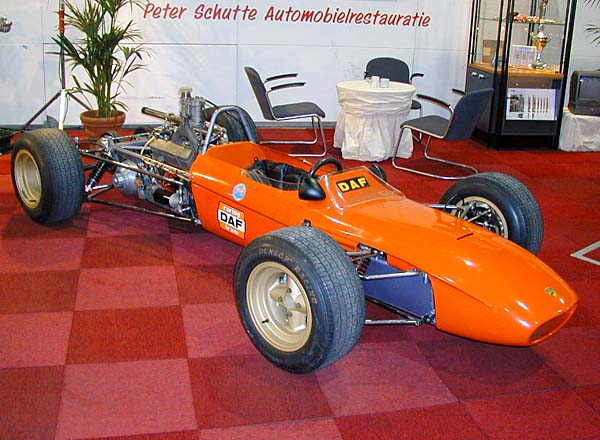 Here you see a more recent
picture of the DAF Formula 3 car of 1968. It has been beautifully restored and painted in
the original Dutch national racing color: bright orange. The car was entered in the 1968
F3 season by Racing Team Holland and drivers were again Beckwith and Van Lennep.
Here you see a more recent
picture of the DAF Formula 3 car of 1968. It has been beautifully restored and painted in
the original Dutch national racing color: bright orange. The car was entered in the 1968
F3 season by Racing Team Holland and drivers were again Beckwith and Van Lennep.
The chassis of this car was built by an Italian company called Tecno. Tecno(kart) started
out as a manufacturer of karts and had at that time just expanded it product range to F3
cars. The 1967 F3 cars of Tecno showed a lot of promise with Clay Regazzoni scoring
Tecno's first win. This potential and the simple layout of the car were the reasons DAF
switched to Tecno. In 1968 the Tecno F3 car made its promise come true by winning 32 of
the 65 major international Formula 3 races; unfortunately none of the victories was scored
by a car of the Racing Team Holland.
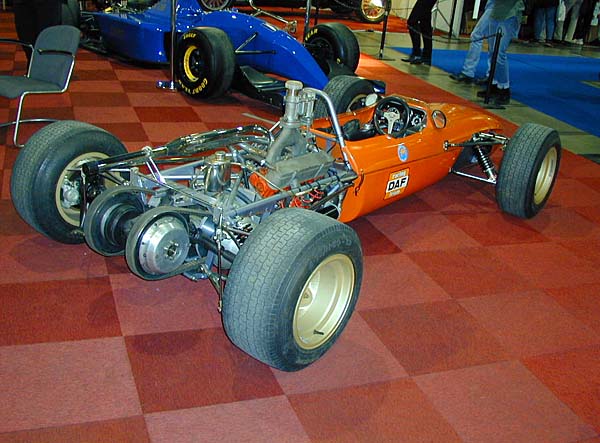 This rear view reveals the
engine/transmission layout and shows that the special Variomatic transmission takes up a
lot of space. The rear pulleys of the transmission are attached to the crankshaft of the
Cosworth MAE engine and stick out of the back of the car. The front pulleys are placed in
front of the rear axle and are linked to the rear wheels. Transmission layout was
therefore reverse to that of the cars.
This rear view reveals the
engine/transmission layout and shows that the special Variomatic transmission takes up a
lot of space. The rear pulleys of the transmission are attached to the crankshaft of the
Cosworth MAE engine and stick out of the back of the car. The front pulleys are placed in
front of the rear axle and are linked to the rear wheels. Transmission layout was
therefore reverse to that of the cars.
The blue car you see (in part) behind the DAF F3 is the 1993 Williams FW15C CVT prototype.
This car was used by the Williams F1 team to test the feasibility of a CVT transmission in
Formula 1. Patrick Head developed this CVT transmission in cooperation with Van Doorne's
Transmissie B.V. (VDT), and it's said that the concept worked well. The FIA, the governing
body of Formula 1, banned all CVT transmissions from single-seater racing in 1994.
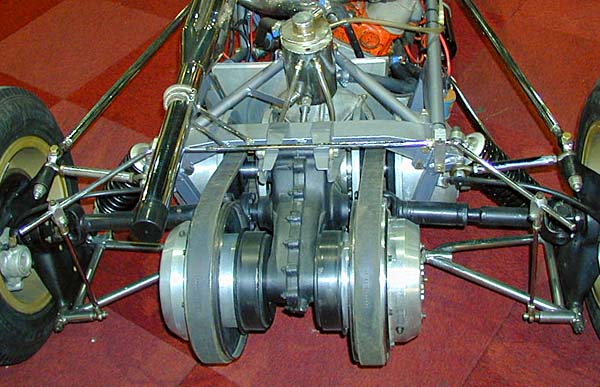 This is the 1968
Formula 3 Variomatic transmission in detail. The wide rubber driving belts are fully
exposed, and that proved to be a weak spot in the design, especially in wet conditions.
The rear axle is constructed out of two independent half-shafts placed between the
transmission's pulleys. The cylinder on top is part of an hydraulic system that operated
the front pulleys.
This is the 1968
Formula 3 Variomatic transmission in detail. The wide rubber driving belts are fully
exposed, and that proved to be a weak spot in the design, especially in wet conditions.
The rear axle is constructed out of two independent half-shafts placed between the
transmission's pulleys. The cylinder on top is part of an hydraulic system that operated
the front pulleys.
More successful was DAF's involvement in rallying. Starting with the Daffodil 32 S in 1966
DAF entered national and international rally events (like the Rally de Monte Carlo, the
Coupe des Alpes, the Tuliprally and the Acropolisrally) and accumulated an impressive
number of class wins. The DAF rallycars excelled in endurance which was best proven by
finishing the 1968 London to Sydney marathon with a DAF 55.
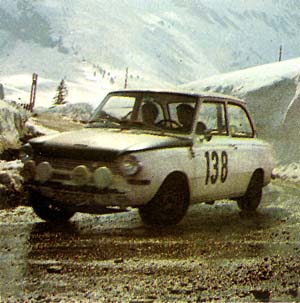
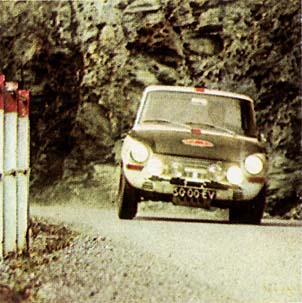
DAF continued its participation in rallying through all of its car
building days, and didn't even stop then. DAF liked the idea of promoting their vehicles
in gruesome marathon rallies so much that the company started entering trucks in the
notorious Paris-Dakar rallies in the late seventies. At first just to finish it and win
the special truck class, but later DAF became more and more ambitious.
It all culminated in the monstrous DAF TurboTwin of 1987, a purpose built all-terrain
vehicle fitted with two turbo charged diesel engines, one driving the front and the other
the rear wheels. It weighed more than 10 ton, had over 1,000 hp and was meant for outright
victory, beating the frontrunners Mitsubishi, Peugeot and Porsche who entered 4x4 cars.
Unfortunately it ended in tears. Only one person could drive this truck: Jan de Rooy, the
man who had developed it over the years and had been the factory driver from the
beginning. But DAF wanted a back-up for if Jan would fail and entered a second TurboTwin.
The driver of that truck was experienced and had taken part in the Paris-Dakar before, but
was too eager and splattered himself and his truck over the Sahara desert at high speed
taking an unexpected sand dune. The DAF company withdrew its remaining trucks (the
TurboTwin of Jan de Rooy and a few back-up trucks with parts for it) immediately and never
(officially) returned since. Some DAF based GINAF trucks have been entered until recently,
but only to carry parts for other teams.
In 1998 DAF Trucks, now part of the American Paccar group, took up truck racing but with
little success. High-tech circuit racing has never fitted DAF. Both DAF cars and DAF
trucks always have been sturdy no-nonsense vehicles, though and fit for their job. A kind
of a "roll up your sleeves and get on with it" character. Fancy circuit racing
just doesn't match with that.
This concludes the DAF cars tour. For more information about DAF cars you can visit the Dutch DAF club homepage.
Finish the tour by clicking the arrows pointing right....
![]()